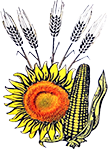Influence of Different Tillage Systems on Abundance and Dynamics of Pests in Maize Crop
Adina Daniela Tărău1, Felicia Mureşanu3, Ana Maria Vălean1, Florin Russu1, Laura Şopterean1, Felicia Cheţan1, Loredana Suciu2, Camelia Urdă1
1Staţiunea de Cercetare-Dezvoltare Agricolă Turda
2Universitatea de Agricultură şi Medicină Veterinară Cluj-Napoca
3Academia de Ştiinţe Agricole şi Silvice „Gheorghe Ionescu-Şişeşti” Bucureşti
Keywords: pests, maize, tillage systems, pheromones, abundance and dynamics.
Abstract: Air pollution, avoiding soil compaction, conserving soil water reserves and reducing farm inputs are just some of the factors that have contributed to new studies regarding maize cultivation technology. In order to evaluate the influence of different tillage systems on abundance and dynamics of pests in maize crop, at Research and Development Station for Agriculture Turda (ARDS Turda) research has been done on estimation the insect populations in these systems. The compared tillage systems were: conventional tillage system (plowing) and minimum tillage system (with chisel). The research consisted of observations and determinations on the monitoring, abundance and dynamics of the most common species pests of maize crop: western corn rootworm (Diabrotica virgifera virgifera LeConte), silver Y (Autographa gamma L.) and turnip moth (Agrotis segetum Den. & Schiff.). Pheromone variants were replaced every four weeks and the adhesive plate every two weeks. The number of males trapped was recorded weekly. The pests monitoring, with economically importance for maize crop, was evaluated using F-1 pheromone traps, with synthetic sex pheromones (atraGAM- 9, atraSEG-21 and atraVIRG). By minimizing the tillage system, there has been an increase in the pest population, especially in Diabrotica virgifera virgifera LeConte.
An almost perfect synchronization of the first generation with the optimal threshold of specific temperatures for insect biology was observed in the three monitored species. These mechanisms formed over the course of evolution and have imposed permanent adaptations of insects to climate changes.
Experimental data reveals that the thermal regime, as expected, has a more important influence on the dynamics of these pests.

